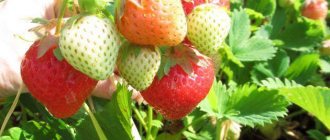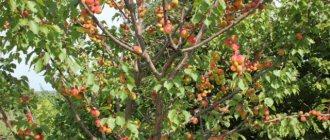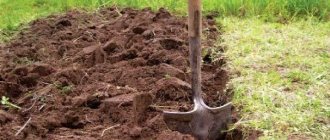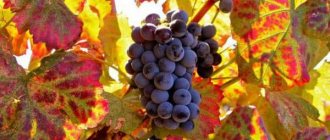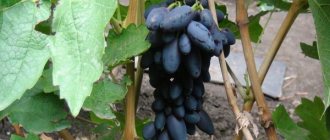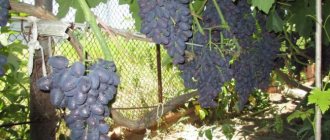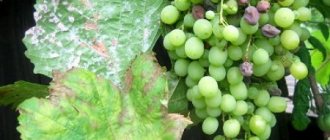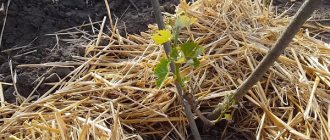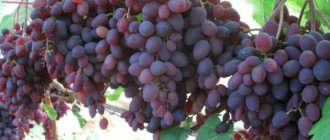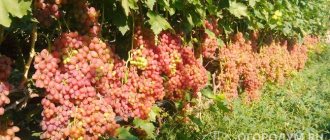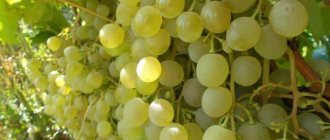a brief description of
The Manicure Finger grape is a table finger variety. However, it is not possible to unambiguously classify it as either a white or a red grape variety.
Similar in appearance to this grape are Black Finger, Witch's Fingers and Lady's Fingers.
Its elongated fruits are light in color at the base and red at the tips. Thus, the berries are surprisingly similar in appearance to a woman’s fingers decorated with bright manicure polish.
The name of the Manicure Finger grape corresponds to its original name Manicure Finger.
The variety is also known under the name Finger nail .
Pros and cons of the variety
Manicure finger, like other plants, has a number of advantages and disadvantages, which should be familiarized with before planting it on the site. The advantages include:
- attractive appearance of ripe fruits;
- high level of productivity;
- taste qualities of berries;
- resistance to diseases.
Among the disadvantages of finger manicure are the following:
- poor resistance to low temperatures;
- susceptibility to sunburn;
- demand for care.
Additional Information
Treatment with gibberellins made it possible to achieve seedless berries, which makes it possible to classify it as a conditionally sultana variety.
Natural raisins are Attica, Kishmish Century, Arsenyevsky and Kishmish Nakhodka.
Which rootstock to choose
Grafting with cuttings Manicure Finger into splinters.
If it is not possible to order a variety on a foreign website, winegrowers try to get at least a cutting.
Regarding rootstocks, experience advises giving preference to medium-sized ones . After conducting experiments and grafting onto phylloxera-resistant Coberra, winegrowers received an excessively fattening vine.
Own root cuttings have been described in different ways, from completely poor results to relatively normal ones.
If the desire is great, then there is a need to try and perhaps you will get the best results in growing the overseas variety “Manicure Finger”.
History of breeding and distribution
Manicure Finger was obtained at the Japanese Grape Research Institute in 1988 from crossing Unicorn No.2 with the Baladi .
In 1998, it began to be cultivated in China.
Now China is one of the main suppliers of vines and cuttings of the variety to the international market.
Recently, one of the farms in the Kharkov region of Ukraine has been growing seedlings.
Grape propagation
Farmers are trying to propagate the Japanese novelty using three methods: cuttings, layering and grafting. The simplest technique is cuttings. To propagate “Manicure Finger” by cuttings, select shoots of the same size. Cut the cuttings into pieces about 50 cm long with 4 formed buds. Next, the planting material must be cleared of leaves and tendrils and immersed in water for a day.
The next step is to treat the cuttings with copper sulfate, which will prevent the formation of mold. At this stage, the planting material is ready for planting in the ground. Annual cuttings can be prepared in the fall and kept in a cool place all winter. There is no official information on the degree of rooting of Manicure cuttings, although some gardeners talk about very active root formation.
To grow grapes by layering, rooted, buried shoots are separated from the mother plant and used as seedlings. However, it is not always possible to propagate “Manicure Finger” in this way. The success of the method depends on whether the old plant will be able to send out new cuttings, thereby rejuvenating the vine.
They also try to propagate the variety by grafting. The method involves combining the rootstock and scion. The rootstock should be of medium height, since in a vigorous specimen the vine actively grows leaf mass. Clear data on the results of propagation by grafting have also not yet been obtained.
Read more about how to properly graft grapes.
Grapes Manicure Finger: variety description
The vigor of the bush is significantly above average. It is recommended to grow it on a T-shaped trellis or arbor, forming the vine in the shape of a wide fan.
Manicure Finger's flowers are bisexual and their degree of pollination is quite high.
Gurzuf Pink, Korinka Russian and Galahad also have bisexual flowers.
The clusters of medium density have an elongated shape, close to cylindrical, and are very attractive in appearance.
The average weight of the bunches is 700 grams . The maximum marked weight of a bunch is 2 kg .
The very large berries have an elongated curved shape with a characteristic color: a light yellow base and a bright red tip.
As the berry ripens, the red color moves higher and higher in the berry, reaching the middle of the fruit when fully ripe.
The length of the berries is up to 5.8 cm , width – up to 3 cm . The average berry weight is 12.6 grams , the maximum is 20 grams . The taste of the fruit is sweet and refreshing, very harmonious.
Black Raven, Victoria and Velika can also boast of excellent taste.
The sugar content in the berries of the variety is about 17.5% . The acidity of the fruit is estimated at 6.1 grams per liter . The pulp is dense and juicy, crispy. The berries are covered with a dense but thin skin.
When eating, the skin is practically not felt.
Diseases and pests
The ability of the variety to resist diseases is low.
Manicure Finger is especially susceptible to anthracnose and white rot. To avoid being affected by these diseases during the season, it is necessary to carry out 2-3 treatments with appropriate drugs.
Preventive treatment against mildew and oidium will not hurt.
This grape is not particularly susceptible to insect pests, which is apparently due to its still limited distribution in our country.
Nevertheless, it can be expected that a grape variety with such unique characteristics will soon become quite widespread in our latitudes.
The hassle associated with its cultivation (shelter, processing) and the still relatively high cost of seedlings are fully compensated by its delightful appearance, high transportability and good taste.
Features of cultivation
According to the ripening period, the grapes are classified as medium and medium-late varieties.
The growing season of the variety is 120-130 days.
When grown in the conditions of Novocherkassk, the harvest ripened in mid-September.
The ripening of the vines is characterized as average or below average. Frost resistance is quite low; it is recommended to cover the bushes for the winter.
Such varieties as Hadji Murat, Cardinal and Ruta also demonstrate a love for warmth.
Attention! At temperatures below -22 degrees, the vine may completely die.
The strong growth of the vine and good fruit set of this grape variety create a risk of overloading the bush. Therefore, when cultivating Manicure Finger, the vine requires fairly strong formative pruning.
Amethyst Novocherkassk, Brilliant and Demeter also need shaping.
After pruning, you should leave no more than 6-8 buds or even less to prevent overload. The fertility coefficient is 1.3-1.5 .
This variety begins to bear fruit the next year after planting. The average yield of berries per bush is 4-5 kilograms . The maximum yield per bush is up to 20 kilograms .
Thanks to the thin but dense skin of the fruit and fairly dense pulp, the grapes are well transported and stored well.
Plant care
Following the subtleties of care will significantly increase the chances of getting attractive yellow-red fruits.
Pruning grape bushes
Pruning for Japanese novelty is a necessity. The procedure helps strengthen the vine by getting rid of unnecessary, old and weak branches. The need for pruning is indicated by a plant height of more than 180 cm and thick foliage covering the stem. Fruits in such conditions are practically not supplied with light, which negatively affects the harvest. In order not to overload the vine, leave no more than 6-8 eyes or even less on it.
Did you know? The oldest 400-year-old vineyard in the world is developing
in the small Slovenian town of Maribor.
This old vine continues to bear fruit and produces grapes for 100 bottles of wine every year. Stepping helps to take care of preserving the growing season and fruitfulness. It is advisable to free the vine from weak and barren side shoots without leaving any residue. Prune the more vigorous ones partially so that they can produce berries in the future.
How to protect grapes from diseases
The grapevine must be treated promptly and correctly with special preparations. Preventative treatment of grapes 2-3 times per season will help prevent the death of the plant from disease.
Since infection with anthracnose is favored by high humidity (rain, morning dew) and wind, try to protect the vine from these negative factors. And at the first signs of the disease (brown spots on the leaves), the plant must be treated with drugs effective against this disease (for example, Gaupsin or Mikosan).
To protect the bushes from white rot, expose the vineyard to the sun from time to time. Also make sure that the bushes do not become overgrown - otherwise natural ventilation will be disrupted. Be sure to get rid of fallen leaves in autumn. Periodically examine the bark for fungi. If it was not possible to avoid infection, cut off and burn all rotten shoots.
We recommend that you find out more details
How to water grapes correctly and how often? To prevent the consequences of gray rot infection, water the bushes with soda solution or potassium iodide. For preventive purposes, it is worth treating the vine against mildew and oidium. The biological product Planriz has proven itself well in the fight against these diseases.
“Manicure Finger” needs regular replenishment with humus, phosphorus and potassium. Select specialized mixtures based on soil type. Apply fertilizer to planting holes before planting seedlings. In addition, after removing the winter shelter, it is necessary to regularly add organic matter. Be sure to enrich the vine with nutrients during the period of cluster formation.
Bushes need to be watered at least once a week. Choose the evening time for this, when the sun is hidden behind the horizon. You need to spend 5–20 liters of water on one plant (depending on the height and development of the bush). After the berries begin to ripen, moistening should be stopped and resumed in the fall, in preparation for winter.
Important! Summer watering is the most important stage in grapevine care. If there is a lack of moisture, the brushes will wither and the growth of the vine will slow down.
Shelter for the winter
Manicure Finger, when grown in open ground, is prepared for winter from mid-October. The grapes are removed from the trellis, and the vines are trimmed of foliage and small shoots. A thick layer of dry straw is placed near the base of the stem. The vines, collected in bunches, are put into it so that they are not visible on the surface. Roofing material is laid on the straw or the film is pressed with a weight. Leave room for air on one edge, otherwise the grapes will freeze.
Pruning and care
Self-rooted bushes are very tall. It is recommended to form them into a wide fan and place them on a T-shaped trellis. Pruning is optimal for 6-8 buds. The fruiting coefficient is close to 1, so there is no need to normalize the yield.
According to reviews of domestic gardeners, the described variety is picky in care. Berries require shading. In bright sun they turn completely red, leaving no colored tip, and may even burn. The variety is not resistant to fungal diseases and requires regular treatments, taking into account the susceptibility to anthracnose and gray mold.
Frost resistance is still being studied, while the stated value is -22ºС. Finger manicure definitely refers to covering forms. Presumably it will be more suitable for the southern regions. Northern winegrowers will have to graft it onto frost-resistant rootstocks and plant it deeper. Experiments with treating inflorescences with gibberellin gave negative results - the berries began to pea.
Reproduction
The question of where to get proven planting material is still relevant. Winegrowers take risks and order it from foreign sites, but they do not always receive what is stated. They are trying to propagate it by grafting, but clear data on the results have not yet been obtained.
When choosing a rootstock, you should choose a medium-growing one, since, for example, on the phylloxera-resistant, vigorous-growing Kober, the hybrid vine becomes too fattening. There is also no verified data on the rooting ability of cuttings of the form, although some winegrowers note very active root formation.
Manicure Finger cuttings can be ordered from China. Quality of planting material on video:
